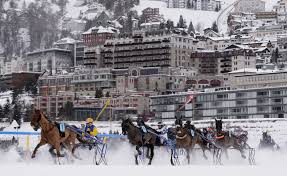Once the excitement of the Prix d’Amerique festivities have quieted down, harness racing fans have only to look to a nearby nation for their next feast of Standardbred excitement.
Celebrating its 117th anniversary this year are the “White Turf” races in Switzerland, where racing takes place over the village of St. Moritz’s frozen lake on February 5, 12 and 19. First organized in Switzerland in 1872, harness races are still held in this ritzy resort village, located in the canton of Graubünden. (Switzerland has 26 cantons, which are similar to our counties).

During February, on three consecutive Sunday afternoons, hordes of up to 30,000 of the elite, rich, and famous gather to experience horse sports on the “White Turf.” With the Alps surrounding them, Standardbreds and Thoroughbreds alike from throughout Europe and Switzerland compete over the frozen St. Moritzersee.
Decorative, snow-suit clad drivers glide over the snow-covered surface with grace and ease, and the freezing temperatures ensure that the lake is solid and hardy enough to accommodate the horses and people who will flock here.
Besides harness racing events, traditional “Skijoring” races are also contested, where upwards of a dozen galloping horses tow courageous skiers behind them for one and five-eighths miles. Skijoring was first contested at St. Moritz at the 1928 Winter Games as a demonstration sport but then was never contested again as an Olympic sport.
However, it remains a highly-popular endeavor—in Switzerland, Scandinavia, and the United States.

Beyond the glamour and festiveness of St. Moritz, racing in Switzerland has evolved into a serious sport. There are 11 racing facilities in this relatively small country—15,941 square miles of land and inland water (similar in size to Ohio) with slightly more than seven million inhabitants. Of these 11 tracks, two—at Basel and Avenches—offer all-weather surfaces, while two—St. Moritz and Arosa—are snow tracks, and the remaining are grass tracks.
Typically, 70 racing days are scheduled annually in Switzerland, with purses averaging around 8,000 Swiss francs each, approximately $8,000US a race. Races are held nearly every weekend and are organized through volunteers and dedicated officials who oversee harness and flat racing, as well as pony and steeplechase events. Some of these one-day programs offer all of these events on a single racing afternoon.
There is an average of 450 Standardbreds that compete annually and a similar number of Thoroughbreds who do so, with 30% of the horses of both breeds being Swiss-bred animals. The remainder are imported from France, Germany, Great Britain and the United States. Curiously, many of these horses race up until their 15th year, and many of the steeplechase horses that race compete well beyond that. Swiss Standardbred breeding is still in the infancy stages, as only a few stallions can be found at a handful of private breeding operations in this land-locked nation.
There are few public Swiss trainers—those who train for other people for a fee—and about 70 people who train one or two horse stables for themselves. As well, there are nearly 600 registered stables/owners in Switzerland. In addition, nearly all of the Swiss drivers are classified as amateurs, and professional drivers, who rarely make an appearance, usually are those who have ventured over from France, Italy, or Germany to drive one or two horses for an elite owner.

While wagering is forbidden under Switzerland’s national Federal Lotteries & Commercial Betting Act, certain Swiss cantons permit limited betting on a sporting event in that specific region. Wagering on horse racing in Switzerland is organized primarily by the Swiss Loterie Romande and is regulated by the French-based PMU (Pari Mutuel Urbain). Gambling is especially popular in the French-speaking areas of Switzerland, primarily in the western edges of the nation.
Racing in Switzerland has many similarities to tracks here in the states. The bigger courses at Avenches, Basel and St. Mortiz all have a professional feel to them, while the smaller tracks are more akin to county fairs.
SKIJORING VIDEO
The rules of racing, however, can be decidedly different. Horses are not allowed to wear tongue-ties or head poles, and drivers mostly wear colors according to their status (apprentice or experienced). While a conventional starting gate is used frequently, a few races are conducted without one, with horses walking in a circle to a particular spot, and when a bell or signal is sounded, they make a quick turn, and all come together for the start.
As well, there is no medication of any kind allowed, including Bute or Lasix.
For those wishing to watch the White Turf events, you can do so via their live webcam at www.whiteturf.ch/live-webcam/.
by Kim Rinker, for Harnesslink

 USA
USA Canada
Canada Australia
Australia New Zealand
New Zealand Europe
Europe UK / IRE
UK / IRE



